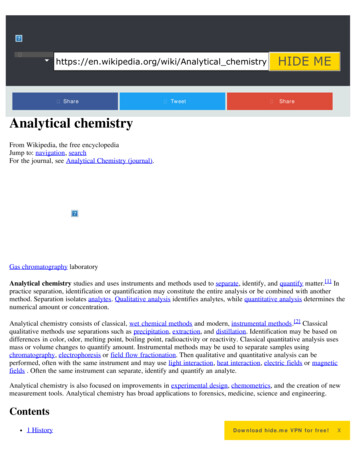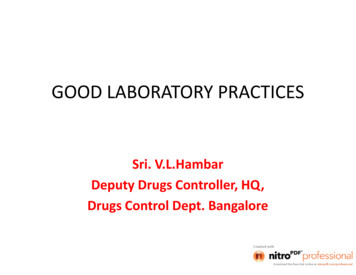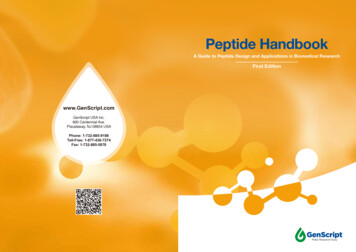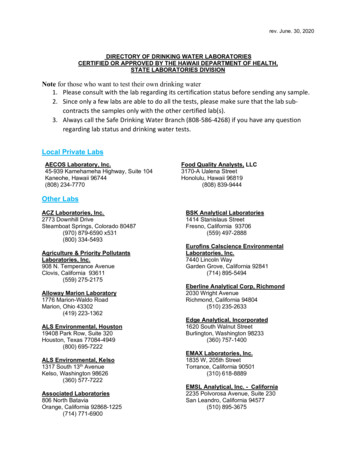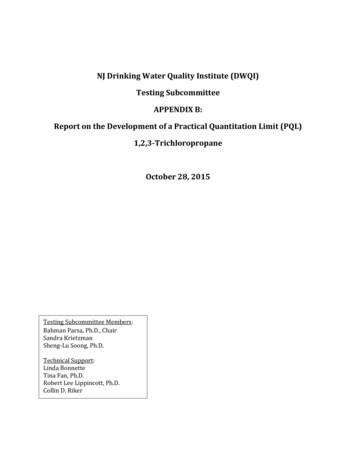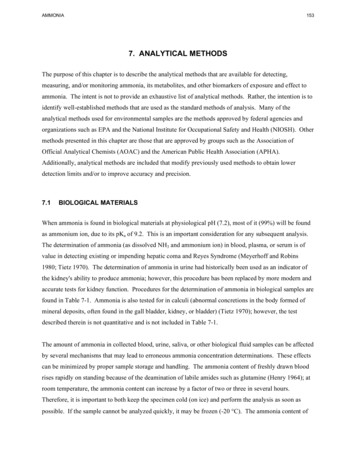
Transcription
AMMONIA1537. ANALYTICAL METHODSThe purpose of this chapter is to describe the analytical methods that are available for detecting,measuring, and/or monitoring ammonia, its metabolites, and other biomarkers of exposure and effect toammonia. The intent is not to provide an exhaustive list of analytical methods. Rather, the intention is toidentify well-established methods that are used as the standard methods of analysis. Many of theanalytical methods used for environmental samples are the methods approved by federal agencies andorganizations such as EPA and the National Institute for Occupational Safety and Health (NIOSH). Othermethods presented in this chapter are those that are approved by groups such as the Association ofOfficial Analytical Chemists (AOAC) and the American Public Health Association (APHA).Additionally, analytical methods are included that modify previously used methods to obtain lowerdetection limits and/or to improve accuracy and precision.7.1BIOLOGICAL MATERIALSWhen ammonia is found in biological materials at physiological pH (7.2), most of it (99%) will be foundas ammonium ion, due to its pKa of 9.2. This is an important consideration for any subsequent analysis.The determination of ammonia (as dissolved NH3 and ammonium ion) in blood, plasma, or serum is ofvalue in detecting existing or impending hepatic coma and Reyes Syndrome (Meyerhoff and Robins1980; Tietz 1970). The determination of ammonia in urine had historically been used as an indicator ofthe kidney's ability to produce ammonia; however, this procedure has been replaced by more modern andaccurate tests for kidney function. Procedures for the determination of ammonia in biological samples arefound in Table 7-1. Ammonia is also tested for in calculi (abnormal concretions in the body formed ofmineral deposits, often found in the gall bladder, kidney, or bladder) (Tietz 1970); however, the testdescribed therein is not quantitative and is not included in Table 7-1.The amount of ammonia in collected blood, urine, saliva, or other biological fluid samples can be affectedby several mechanisms that may lead to erroneous ammonia concentration determinations. These effectscan be minimized by proper sample storage and handling. The ammonia content of freshly drawn bloodrises rapidly on standing because of the deamination of labile amides such as glutamine (Henry 1964); atroom temperature, the ammonia content can increase by a factor of two or three in several hours.Therefore, it is important to both keep the specimen cold (on ice) and perform the analysis as soon aspossible. If the sample cannot be analyzed quickly, it may be frozen (-20 C). The ammonia content of
AMMONIA1547. ANALYTICAL METHODSTable 7-1. Analytical Methods for Determining Ammonia in Biological SamplesSamplematrixPreparation methodUrine24-Hour specimen, addHCl, refrigerateUrine24-Hour specimenanalyzed immediately, orstored up to 8 weeks at-20 CFreeze at -20 C for up to2 weeks, or store for 1 hourat 4 C, or entdetection limit dophenolreactionNot reportedNot reportedTietz 1970Not reportedNot reportedHuizenga etal. 1994Not reportedNot reportedHuizenga etal. 1994Not reportedNot reportedHuizenga etal. 1994Not reportedNot reportedHuizenga etal. 1994Not reported-7.0–14% error, Meyerhoff102% average and ctrodeSerum,Freeze, then store at -15 C Colorimetricplasma,for several days, or storeassay basedwhole blood on ice (4 C) for 30–on indophenol60 minutes, or analyzeproductionimmediatelySerum,Freeze, then store at -15 C Titrationplasma,for several days, or storewhole blood on ice (4 C) for 30–60 minutes, or analyzeimmediatelySerum,Freeze at -30 C or storeMembraneplasma,on ice, or analyzebasedwhole blood immediatelyammoniaselectiveelectrode
AMMONIA1557. ANALYTICAL METHODSiced (4 C) blood samples remains constant for up to 60 minutes, whereas the ammonia content of frozen(-20 C) blood samples remains constant for several days (Huizenga et al. 1994; Tietz 1970). For bloodsamples collected from a healthy person (and stored on ice), the ammonia content should be measuredwithin 30–60 minutes of collection. For persons suspected of suffering from liver disease, however, theblood samples should be analyzed within 15 minutes (Huizenga et al. 1994). This more rapid assessmentis necessary because some liver diseases result in high levels of γ-glutamyl transferase, an enzyme thathydrolyzes glutamine; the enzyme’s activity will increase the concentration of ammonia in the sample tolevels higher than was present at the time of collection (Huizenga et al. 1994). Other erroneously highmeasured ammonia levels can result from ammonia contamination of reagents or pick-up of ammoniafrom the atmosphere, including from technicians that have recently smoked a cigarette (Huizenga et al.1994). The presence and activities of bacteria in samples can also cause changes in the concentrations ofammonia. The natural presence of bacteria present in some samples (e.g., saliva) or their presence ininfected tissues (e.g., bladder infections) can lead to erroneously high ammonia concentrations, due to thepresence of bacterial ureases that hydrolyze urea present in the biological samples. This reaction is thechief cause for the formation of ammonia in unacidified urine on standing (Henry 1964). Furthermore,contamination of samples by environmental bacteria following the collection of the sample may also leadto increases in ammonia concentrations. Therefore, use of sterile collection bottles for sample collectionand storage is recommended if there is potential for storage of the sample prior to analysis (Huizenga etal. 1994).In the determination of ammonia or ammonium ion in biological samples, ammonia is first liberated bydistillation, aeration, ion-exchange chromatography, microdiffusion, or deproteinization (Huizenga et al.1994). Deproteinization methods involve treatment of blood or plasma fluids with trichloroacetic acid (orperchloric acid or tungstate-sulfuric acid), followed by centrifugation. The protein-free supernatant canbe assayed colorimetrically for ammonia. Traditionally, Kjeldahl distillation methods have been used todetermine ammonia levels in biological tissue, but other methods (e.g., colorimetric or ion-specificelectrodes) are also available. In the Kjeldahl distillation, ammonia is distilled and subsequently trappedin acid and analyzed titrametrically or colorimetrically. High values sometimes result because of thecleavage of protein amino groups and also the formation of ammonia by deamination reactions (Parrisand Foglia 1983). Other techniques use the ammonia-selective electrode and enzymatic assays.Discrepancies have been reported between results using electrodes and those using more specificenzymatic procedures because the ammonia electrode responds to both ammonia and volatile amines(Parris and Foglia 1983). Chromatographic separation of ammonia and volatile amines afterderivatization has also been used to obtain specificity (Huizenga et al. 1994; Parris 1984). Ammonia in
AMMONIA1567. ANALYTICAL METHODSurine has been measured by Nesslerization, as well as by enzymatic assays and chromatographicapproaches (Huizenga et al. 1994).7.2ENVIRONMENTAL SAMPLESWater and waste water samples can be analyzed for ammonia by EPA Test Methods 1689 (EPA 2001a),1690 (EPA 2001b), and 349.0 (EPA 1997). Analogous procedures (i.e., Method APHA 4500) have beenapproved and published jointly by the American Public Health Association, American Water WorksAssociation, and Water Pollution Control Association. These methods are suitable for drinking, surface,and saline waters, and domestic and industrial effluent, and can be applied to biosolids. These and othermethods for determining ammonia in environmental samples are listed in Table 7-2. Ammonia isreported as ammonia nitrogen. Two methods that are suitable for water employ colorimetric techniques,Nesslerization, and phenate methods. Nessler's reagent, an alkaline mixture of mercuric and potassiumiodide, produces a yellow to brown color with ammonia, whereas the phenate reagent, alkaline phenol,and hypochlorite produce a blue color (EPA 2001a, 2001b; Greenberg et al. 1985). In the titrimetricmethod, the distillate is titrated with standard sulfuric acid with an appropriate indicator. The ammoniaelectrode employs a hydrophobic gas-permeable membrane to separate the sample solution from aninternal ammonium chloride solution: ammonia diffusing through the membrane changes the pH of theinternal solution and is sensed by a pH electrode. For determining NH3-N concentrations above 5 mg/L,the titrimetric and ammonia-selective electrode methods are preferred. In contrast, gas chromatography/mass spectrometry methods have been developed that permit NH3 detection at concentrations near20 µg/L for environmental waters (Mishra et al. 2001). Methods for determining ammonia in water andsoil measure ammoniacal nitrogen, the sum of NH3 and NH4 . In the determination of ammoniacalnitrogen in soil, exchangeable ammonium should be distinguished from nonexchangeable ammonium.The former is usually defined as that which can be extracted with KCl (or K2SO4) at room temperature(Bremner 1965). Nonexchangeable ammonium ion is defined as nitrogen held by clays and not displacedby 2M KCl (Bremner 1965). In the determination of nonexchangeable ammonium, organic forms ofammonia are first removed, the minerals containing the nonexchangeable ammonium are thendecomposed with HF, and the ammonium ions released. In colorimetric procedures, turbidity and samplecolor may lead to interference. To eliminate interference, the pH of the sample may be raised and theammonia distilled. Care should be taken to prevent losses in water samples due to volatilization andmicrobial transformation. To prevent such losses, samples should be acidified soon after collection andrefrigerated. Care should also be taken during storage and treatment of soil samples to prevent ammonia
AMMONIA1577. ANALYTICAL METHODSTable 7-2. Analytical Methods for Determining Ammonia in nalyticalmethodSamplePercentdetection limit recoveryReferenceAirPassive collectionusing 0.01 N H2SO4in liquid sorbentbadgeAir samples fromstack emissionscollected through anin-stack filter toremove particulatesand ammoniumsalts, and thenbubbled through0.1 N H2SO40.8 µm prefilter maybe used; ammoniatrapped on sulfuricacid silica gelMethod 6701, ionchromatography,conductivitydetectionEPA Method 30;ion chromato graphy1 µgNH3/sampleNo bias between6.9 and 48 ppm; 19% at148 ppm98.5 1.3%; Biasof 0.996 ppm fora spiked sampleof 6.43 ppm.Correction factorof 0.87 needs tobe appliedNIOSH19870.5 µgNH3/sampleNot determinedNIOSH19942 µgNH3/sample102 3.8%NIOSH19966 µgNH3/sampleNot reportedErxleben etal. 20002 µgNH3/sample95–110%recoveryBishop etal. 1986Not reported97.6% meanrecoverySRI 19880.1 mg/LNot reportedEPA 2001aAirAirAirAirAirAirWaterNIOSH method6015, Colorimetricdetermination ofindophenol byvisible lightspectrophotometry0.8 µm prefilter may NIOSH methodbe used; ammonia 6016. Iontrapped on sulfuric chromatographyacid silica gelChromatomembrane Ion chromato cells preextract and graphy ction in H2SO4 Ion chromato graphycoated activatedcarbon beads insampling tubeKnown volume of air NIOSH S347,ammonia-specificdrawn throughprefilter and H2SO4 electrodetreated silica gelSample mixed with Method 1689, ionborate bufferselective probe1 µgNH3/sampleEaton et al.1996
AMMONIA1587. ANALYTICAL METHODSTable 7-2. Analytical Methods for Determining Ammonia in nalyticalmethodSamplePercentdetection limit recoveryReferenceWaterSample collected,preserved withH2SO4, and chilledto 4 C. Samplesshould not be storedfor 28 days0.2 mg/LNot reportedEPA 2001bWaterNoneMethod 1690,colorimetricdetermination ofindophenol blue,following reactionof any ammoniawith alkalinephenol and hypo chloriteMethod 350.1colorimetric,automatedphenate0.1 mg/LEPA 1983Estuarine andcoastal waterSamples filteredthrough 0.45 µmmembrane filter,refrigerated andanalyzed within3 hoursRemoval of residualchlorine with sodiumthiosulfate,distillation107 and 99%recoveries at0.16 and1.44 mgNH3-N/L,respectively92.2–109.1%recovery, n 140.05 mg N/L forcolorimetric andpotentiometric;1.0 mg N/L fortitrametric28.12 to -0.46Rbias between0.21 and1.92 mg N/LEPA 19830.03 mg N/L96 and 91%recoveries at0.19 and0.13 mg N/L,respectivelyNot reportedEPA 1983Not reportedBremner1965WaterWaterNoneSoil, exchangeableammoniumSoil, nonexchangeable(fixed)ammoniumExtract soil with 2NKClMethod 349.0,automatedcolorimetricdetermination byreactions that formindophenol blueMethod 350.2Nessier reagent,colorimetric,titrimetric; orammonia specificelectrodeMethod 350.3 ionselective electrode0.3 µg/LMethod 84-3,Not reportedsteam distillationwith MgO, titrationPretreat soil withMethod 84-7,Not reportedKOBr-KOH, shake steam distillationwith 5 N HF-1N HCl with KOH, titrationfor 24 hoursEPA 1997aBremner1965
AMMONIA1597. ANALYTICAL METHODSloss or gain. It has been demonstrated that dry soil can rapidly adsorb trace amounts of ammonia from theatmosphere and that extensive amounts of ammonia can be lost during air drying (Bremner 1965).Additionally, in samples containing both ammonium and nitrite, losses during air drying may occur due tothe reaction between these ions and the resulting formation and release of nitrogen gas (Bremner 1965).The detection limit of analytical methods for determining ammonia in air depends on the amount of aircollected in a liquid or solid adsorbent. Sampling is performed with passive samplers or by drawing avolume of air through the adsorbent using a pump. Particulate contaminants such as ammonium saltsmay be removed by a prefilter. For determination of ammonia in the ambient atmosphere, larger volumesof air must be sampled than those appropriate for determinations of ammonia in occupational settings(e.g., industrial, agricultural) where ammonia levels are higher. Improvements in methodologies have ledto development of techniques that permit continuous monitoring of atmospheric ammonia down to0.1 µg/m3 (Pranitis and Meyerhoff 1987). Several passive monitoring systems report detection limits of0.05–1.0 µg/m3 and have collection rates ranging from 2.7 to 2,000 mL/minute (Kirchner et al. 1999).One method used for ambient atmospheric sampling employs a specially designed flow-through,ammonia-selective electrode with a sniffer tube, whereas the methods used for occupational settings oftenuse passive collectors with media (usually acids impregnated onto filters) housed within protective cases.Ammonia concentrations on these passive collectors are then determined by a wide range of methods,including colorimetric assays (e.g., indophenol determination), the Berthelot reaction, or ionchromatography (Kirchner et al. 1999).Ammonia may be present in air in both the vapor phase as ammonia gas and in the particulate phase asammonium salts. While some analytical methods may distinguish between these phases, most standardmethods do not. Methods have been developed that determine gaseous ammonia alone or gaseous andparticulate forms of ammoniacal nitrogen separately. These methods use filter packs or sampling tubescoated with a selective adsorbent (denuder tube) to separate the phases (Dimmock and Marshall 1986;Knapp et al. 1986; Rapsomanikis et al. 1988). In these methods, gaseous ammonia is trapped by acidsthat act as adsorbents (e.g., citric acid, oxalic acid, phosphoric acid) on a coated filter or denuder tube(Kirchner et al. 1999). In filter methods, errors may arise due to ammonia interactions occurring on thefilter and volatilization of retained ammonium salt (Dimmock and Marshall 1986; Rapsomanikis et al.1988). There is evidence that ammonium nitrate in particulate matter is in equilibrium with ammonia.The presence of ammonium nitrate may lead to overestimation of the actual concentration of ammonia,but underestimation of the concentration of ammonium (Doyle et al. 1979). For additional review of the
AMMONIA1607. ANALYTICAL METHODSmethodologies for determining ammonia in water and air, see MacCarthy et al. (1987) and Fox (1987),respectively.7.3ADEQUACY OF THE DATABASESection 104(i)(5) of CERCLA, as amended, directs the Administrator of ATSDR (in consultation with theAdministrator of EPA and agencies and programs of the Public Health Service) to assess whetheradequate information on the health effects of ammonia is available. Where adequate information is notavailable, ATSDR, in conjunction with the National Toxicology Program (NTP), is required to assure theinitiation of a program of research designed to determine the health effects (and techniques for developingmethods to determine such health effects) of ammonia.The following categories of possible data needs have been identified by a joint team of scientists fromATSDR, NTP, and EPA. They are defined as substance-specific informational needs that if met wouldreduce the uncertainties of human health assessment. This definition should not be interpreted to meanthat all data needs discussed in this section must be filled. In the future, the identified data needs will beevaluated and prioritized, and a substance-specific research agenda will be proposed.7.3.1Identification of Data NeedsMethods for Determining Biomarkers of Exposure and Effect.No known unique biomarkersfor exposure or effects exist for ammonia. Until one has been identified, methodology for thedetermination of biomarkers must be preceded by an experimental determination of a unique biomarker ofhuman exposure or effect.Methods for Determining Parent Compounds and Degradation Products in EnvironmentalMedia.Methods for determining ammoniacal nitrogen in environmental media are well developed andadequate. Standardized methods are available from EPA, NIOSH, and other sources. Analytical methodsare also well developed for oxidation products of ammonia. Since there are multiple sources of thesecompounds in the environment, their analysis is not generally used to study the disappearance ofammonia.
AMMONIA1617. ANALYTICAL METHODS7.3.2Ongoing StudiesThe Federal Research in Progress (FEDRIP 2003) database provides additional information obtainablefrom a few ongoing studies that may fill some of the data needs identified in Section 7.3.1. These studiesare summarized below and in Table 7-3. By and large, most of the studies that were reported were relatedto the detection and measurement of atmospheric ammonia concentrations. Many of these focused on thedevelopment of novel sensor devices, which would provide better data for estimating ammonia emissionand deposition rates. A company in Atlanta, Georgia is developing an optical ammonia sensor to measureagricultural emissions. This sensor is capable of detecting ammonia concentrations at the 100 ppb rangeand above. Similarly, the Georgia Institute of Technology is developing an optical sensor that will permitmeasurements of ammonia in the atmosphere at the 100 ppb range. Another company in Burlington,Massachusetts is developing a diode laser absorption remote sensor for measuring ammonia at traceconcentrations, but no detection ranges have been specified. Another company in Massachusetts isdeveloping a solid-state electrochemical sensor that is based on ionomer (i.e., an ion-containing polymer)membrane technology. This technology, however, is not intended for atmospheric ammonia sampling,but for instrument monitoring where ammonia gas may have negative impacts. This particularapplication seeks to produce these monitors for use in fuel cell systems, where free ammonia cannegatively impact performance.
AMMONIA1627. ANALYTICAL METHODSTable 7-3. Ongoing Studies on the Development of Analytical Approaches to theStudy of AmmoniaInvestigatorAffiliationAttar AJDevelopment of a low-cost ammonia detector(a small detector panel, about the size of acredit card, that changes color in response toammonia in the atmosphere) for use in animalproduction facilities.Development of an optical ammonia sensor toPhotonic Sensors,measure agricultural emissions. This sensorAtlanta, Georgiais capable of detecting ammoniaconcentrations at the 100 ppb range.Development of a diode laser absorptionSpectral Sciences,sensor for measurement of traceBurlington,concentrations of ammonia, for potentialMassachusettsapplications in atmospheric chemistry andpollution monitoring.Development of a solid-state electrochemicalGiner, Inc.,sensor that is based on ionomer membraneWaltham,technology for instrument monitoring whereMassachusettsammonia gas may have negative impacts.Northwest Instrument Development of an online system foranalyzing ammonia (and other nitrogenSystems, Richland,containing chemicals) in water systems.WashingtonDevelopment of an optical ammonia sensor toGeorgia Institute ofmeasure agricultural emissions. This sensorTechnology,is capable of detecting ammoniaAtlanta, Georgiaconcentrations at the 100 ppb range, andwould be useful for real-time monitoring of theinjection of anhydrous ammonia fertilizer ontocrops.Edwards JGoldstein NLaconti ABOzanich RMWalsh JL Jr.Research descriptionPerfect View, Inc.,Raleigh, NorthCarolinaSource: FEDRIP 2002, 2003SBIR Small Business Innovative Research; U.S. DOE U.S. Department of EnergySponsorSBIRCooperativeAgreementU.S. DOESBIRSBIRU.S. DOE
The ammonia content of freshly drawn blood rises rapidly on standing because of the deamination of labile amides such as glutamine (Henry 1964); at room temperature, the ammonia content can increase by a factor of two or three in several hours. Therefore, it is important to both keep the specimen c







